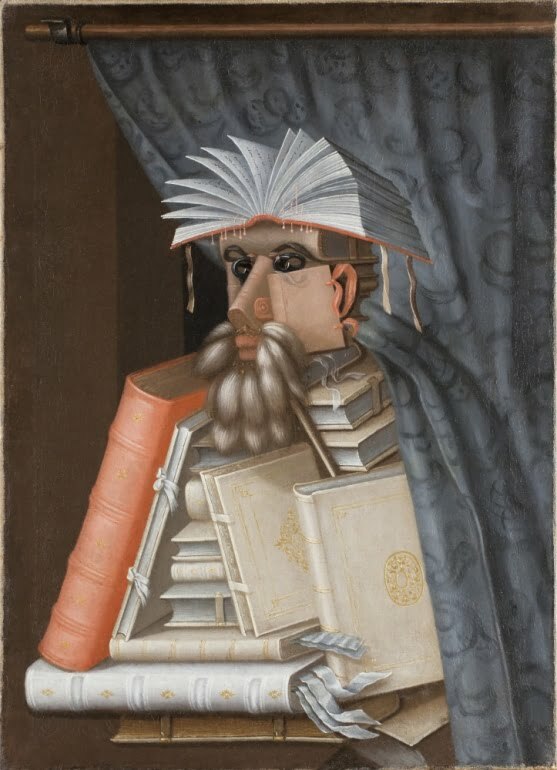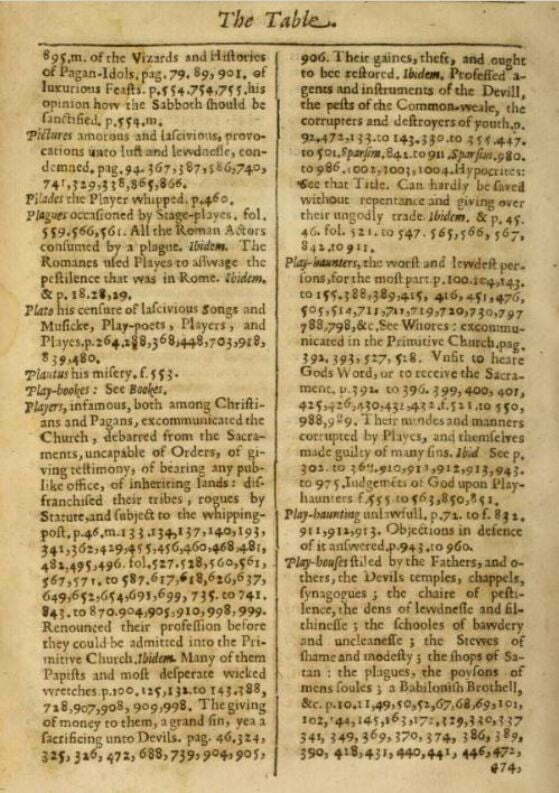
Some years ago I had a bright idea. It was for a mechanism which would bring together all of the indexes of digitised books to make one super-index linking back to each of those texts. Yes there would be huge unevenness between the individual indexes, and yes it had a Borgesian air about it (Borges’ story ‘The Library of Babel‘ envisages a vast library containing every permutation of book, though of a particular size, to which there would have to be a single volume that provided the key to the rest, if only anyone could ever find it). But it need not have been wholly universal in its ambition. It might be applied to the publications of a single publisher. You would just need the digital texts, from which you would extract the indexes at the end, collate all of these in their naturally alphabetical order, each tagged by the book to which they belonged and the page numbers, of course. What seemed fanciful fifteen years ago could probably be pulled together by some bored data scientist on a wet afternoon. Google are just around the block from where I work – perhaps I should pop round and make the suggestion. Perhaps they are already working on it, or more likely on the brilliant next stage of the idea, that which lies beyond my humble comprehension.
I am a connoisseur of indexes. When I pick up a new non-fiction book I will always turn to the index, judging it for its range and clarity, checking a few of the references to see how they lead the reader to where they need to go. When reading a book and coming across an elusive term, I will check the index to see if the indexer picked up on it. I wince at indexing inaccuracies, all too often not the fault of indexer but of the publisher, who has made a last-minute adjustment to the pagination and has thrown some of the index numbers out by one. I have raged at books that have no index yet demand one. I have produced several indexes myself, so I know something of the time and discipline required, as well as having a sympathetic understanding of how no index can ever be perfect. The index can never be all-seeing (as Borges’s librarians imagine). It must always miss something, being finite (particularly when the publisher is strict about the page length available). Like any creative work, it tries to distil and by doing so to comprehend, but is fated never to succeed entirely. Accepting that is an essential part of good indexing.
The index is a work of art that needs to hide its artistry. Many indexes succeed all too well with the latter, being purely functional lists of the essential terms. The index has become a burden for many publishers, particularly in the academic sector, with a rudimentary index covering too few pages with scant feeling for shape, style or function (as the contributor to a book of essays I was recently asked by the publisher to suggest the index terms for my essay alone, to which they will presumably add the terms put forward by other contributors for their parts, resulting in what can only be an irrational inconsistent mess). Other indexes pinpoint their subjects more fully, but only by producing a long list of page numbers without further indication of what those pages will contain. This is indexing as a duty, not as a pleasure.
The index must reveal more. A sophisticated index, such as that for a book I am currently reading, George Orwell: A Life in Letters, edited by Peter Davison, is a complex mechanism designed for optimal discovery. Some page references are in bold (indicating biographical notes), some are italicised if they are of significance, while ordinary references are in plain roman. Individual letters (i.e. the correspondence) are marked with an L and a page number. But a model index does more than manage the numbers. For a particularly fine example, see that in Richard Ellmann’s biography of James Joyce (naturally no one is credited for the index, presumably an Oxford University Press employee):

Where a subject is mentioned more than once, each number is followed by a description of that aspect of the subject to which it particularly refers. For references to the major characters of Leopold and Molly Bloom, the index reveals the book’s richness of approach (and by extension Joyce’s novel Ulysses to which they belong). The index imaginatively complements its source, in style and depth. It partakes of the particular quality of the text.
It is possible for such artistry to veer towards facetiousness or satire. A delicious example is the wholly appropriate index to D.B. Wyndham Lewis and Charles Lee, The Stuffed Owl: An Anthology of Bad Verse (1930), which has such fun suggesting to us the sheer dreadfulness of what lies within the receding pages – as the entries for D and E indicate:
Daughters of the plain, guileless, chased by Henry, 82; of the great, illustrious, recalled to their maternal duties, 95
David, King, blue-pencils a score of Mr. Purcell’s, 37
Death. See Monster, grim
Dentist, refuge of the suffering fair, 13
Deprecation, yell of, emitted by scared native, 138
Dorsal region, bright, 1; lunar, glorious, 12
Drains. See Sewage system
Drunkards. See Bacchanal, Costermonger, and FeatherbedsEarl, a superb old, 177; rush of M.D.s to his deathbed, 178
Edward, inexplicable ignorance of, 149
Eggs, mention of, wrapped in elegant obscurity, 62
Elephant, not amphibious, 58
Eliza takes children to see a battle, 106; gets it in the neck, ibid.
England, small but well known, 200; emphatically under generate 202
Englishman, his heart a rich tough gem that leaps and strikes and glows and yearns, 200-1; sun never sets on his might, 201; thinks well of himself, ibid.
Ether, bales of, 41
It is curious, given the creative possibilities of the index, not to say its plain usefulness, that so few fictional works make use of one. Consider all those lengthy nineteenth century novels with casts of hundreds, where some point of action relates to an earlier action you read weeks before; now you need to find that reference to work out who has just insulted who, and for what slight, twenty chapters ago. Yet so few help us. Examples among notable novels include Virginia Woolf’s Orlando (surprisingly conventional), Georges Perec’s Life: A User’s Manual (eye-opening for the breadth of the author’s passions), later editions of J.R.R. Tolkein’s The Lord of the Rings (suitably epic) and Vladimir Nabokov’s Pale Fire (entirely fictional since the page numbers bear no relation to the text).
Standing above all these is another index to a volume of poetry, namely that supplied by the poet herself to Marianne Moore’s 1924 volume Observations. The index serves as a guide to the preceding poetry, but it has a wry, elusive quality that is poetic in itself. Consider the entries for the letter F below. The titles of poems are given in capitals, and are the genuine titles, but separated out among the subject terms they have become mysterious. The terms themselves are both reliable yet playful. Why is feeling only to be found on pages 49 and 299? (the page numbers are changed for new editions of her poetry with new pagination) Why signify ‘four o’clock’? What is it with Anatole France and moonstones? And what is missing from so selective an index and why? What has been revealed? It is not an index for searching but for contemplation.
Fables of La Fontaine, 305
Faguet, on Fontaine, 302
FEAR IS HOPE, 11
feeling, 48, 299
feline, 64, 303
Filles et Garçons, 303
FISH, THE, 39
fish, and phantasmagoria, 13; catches more, 50; Egyptian, 16; investigate, 52; school of, 32
Flaubert, 302
Florida, 78
FOOL A, A FOUL THING, A DISTRESSFUL LUNATIC, 14
fools, 68
Forsyth, P.T., 302
four o’clock, 67
France, A., an idol, 65, 303; buyer and seller, 61, 302; moonstones, 57, 301
French greens, 48, 299
Fujiyama, 73
Other indexes are fun simply for being of their age. The index as a part of a published book dates back to the end of the sixteenth century, and while the basic function has remained the same, the terms and tone tend to be of the period. Kevin Jackson, in his entertaining book on literary curiosities, Invisible Forms, which has a chapter on indexes, highlights the example of 17th-century lawyer William Prynne, whose vast attack on the theatre, Historio-Mastix: the players scourge (1632), “boasts one of the most insanely splenetic indexes of all time, forty pages long and bursting at the seams with bile”:

For a gentler example, at the British Library we recently acquired a bound volume of British newspaper The News for 1818. Newspapers at this time were sometimes bound into annual volumes for use in reading rooms, and would often be indexed. Not too many of these indexes survive, alas (so many volumes have been split up for the sale of individual issues to collectors), especially when they are as entertaining and redolent of their period as we see with The News. Here is the richness the life, demanding that you turn to each page to find out more:

The dictionary calls an index “an alphabetical register of subjects death with, usu. at the end of a book, with page or folio references” (Chambers English Dictionary). But it is more than that. It is, as I’ve said, a creative work. It represents not only skill on the part of the indexer and helpfulness on the part of the publisher, but is a human reaction to the world’s complexities. It aims to guide, to explain, to distil, to reflect its source. Marianne Moore understood that it could have the quality of poetry.
But not all indexes are poetic. Most are functional at best, and as computerisation and the short-cuts by publishers needing to reduce costs increasingly take over, so that is all they may ever become (professional indexers make use of software programmes to speed up their work, while there are computerised efforts to extend the extraction of knowledge beyond the index by showing new kinds of relationship, through innovations such as entity extraction, topic maps or concepts maps, but these belong to the Semantic Web, not to the physical world of the printed book). They will lose their insightfulness, because that lies as much in what is left out as what appears on the page (again, as Marianne Moore understood). We can show our knowledge by what we decline to spell out. And that is something a machine will never understand.
Links:
- Jonathan Basile’s playful site The Library of Babel attempts to be an online expression of Borges’ vision
- William Denton at the ‘Miskatonic University Press’ site (not a real publisher) has an entertaining list of works of fiction that comes with footnotes and/or indexes
- Need an indexer? The Society of Indexers can help you